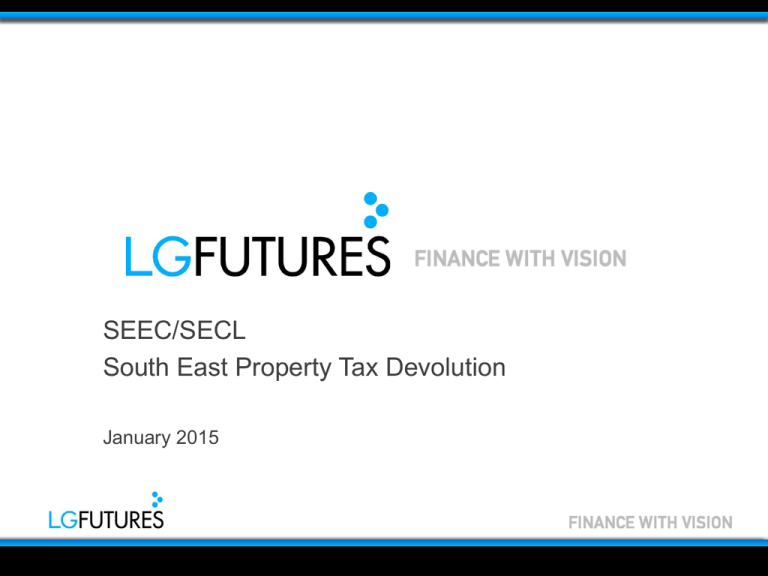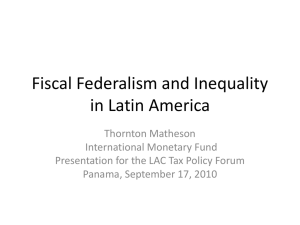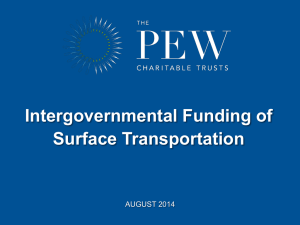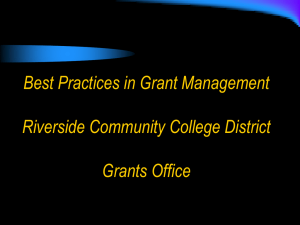Property Taxes – Analysis - Hampshire County Council
advertisement

SEEC/SECL South East Property Tax Devolution January 2015 Report overview 1. Objectives of the Work 2. Fiscal Balance 3. Property Taxes – Overview 4. Property Taxes – Analysis 5. Conclusions 2 1. Objectives of the Work Identify headline property tax figures for the South East, consistent with the report by the London Finance Commission’s (LFC’s) 2013 report, “Raising the Capital”. Specifically, quantify the values of (i) council tax, (ii) business rates, (iii) stamp duty land tax, (iv) annual tax on enveloped dwellings, and (v) capital gains tax on property disposal. Estimate total property tax for each local authority in the South East, based upon assumptions about potential apportionment bases. Compare against local authority funding from central government. 3 1. Objectives of the Work Definitions: (i) Council Tax – levied on households, based on property value and occupancy (ii) Business Rates – levied on non-domestic property, based on rateable value (iii) Stamp Duty Land Tax – on ‘land’ transactions, including property (based on purchase price), leases, rent (iv) Annual Tax on Enveloped Dwellings – payable by companies, partnerships, investment vehicles that own high value residential property, based on property value (v) Capital Gains Tax on Property Disposal – on the ‘gain’ from the sale/disposal of property (but note that the LFC only considered property owned by companies). 4 2. Fiscal Balance To provide context, we begin with an overview of the balance between total tax revenue and total public expenditure in the South East. Oxford Economics estimates that, in 2011/12, the South East had resident-based revenues of £88.5bn, compared to a share of total public expenditure of £84.0bn. This translates to fiscal balance of +£4.5bn, second only to London. Since 1999, the South East’s net fiscal contribution has averaged +£10.2bn per year. This ‘return on investment’ contracted sharply in the wake of the global financial crisis, and has since partially recovered. 5 6 2011/12 2010/11 Revenues 2009/10 2008/09 2007/08 2006/07 2005/06 2004/05 2003/04 2002/03 2001/02 2000/01 1999/00 £bn Revenue / Expenditure Fiscal Balance Figure 1 – South East Fiscal Balance Expenditure 100 75 50 25 0 -25 7 2011/12 2010/11 100 20 75 15 50 10 25 5 0 0 -25 -5 £bn Fiscal Balance Revenues 2009/10 2008/09 2007/08 Fiscal Balance (right axis) 2006/07 2005/06 2004/05 2003/04 2002/03 2001/02 2000/01 1999/00 £bn Revenue / Expenditure Fiscal Balance Figure 1 – South East Fiscal Balance Expenditure Fiscal Balance The fiscal balance captures all major sources of tax revenue and public expenditure in the UK. Public expenditure includes services that are typically outside the remit of local government, such as health care, welfare payments and defence. Oxford Economics’ measure of tax revenues include all major revenue streams, including: Income tax National Insurance Contributions (NICs) Value Added Tax (VAT) Corporation tax Council tax Business rates 8 Fiscal Balance An earlier study by Oxford Economics (London’s Finances and Revenues) included a breakdown of the South East’s tax revenues in 2010/11. Figure 2 – South East Tax Revenues, 2010/11 4.9% 3.6% 1.6% 0.6% 20.0% Council Tax Business Rates Stamp Duty Capital Gains Tax* 5.9% Income Tax 30.6% NICs 15.1% VAT Corporation Tax 17.6% Other * Capital Gains Tax also includes financial assets, and so is not a pure property tax 9 Fiscal Balance Overall, it showed that property taxes accounted for only 11% of the region’s total tax take. Figure 2 – South East Tax Revenues, 2010/11 11% Council Tax Business Rates Stamp Duty Capital Gains Tax* Income Tax NICs VAT Corporation Tax Other * Capital Gains Tax will also include financial assets, and so is not a pure property tax 10 3. Property Taxes - Overview The following sections focus on property taxes in the South East, in the context of the London Finance Commission’s (LFC’s) report, “Raising the Capital”. The report calls for the devolution of all property taxes. It is argued that this would increase the capital’s autonomy to invest in infrastructure, promote economic growth, and increase accountability to local residents and businesses. Specifically, the commission calls for the devolution of: 1. Council tax 2. Business rates 3. Stamp duty land tax (SDLT) 4. Annual tax on enveloped dwellings (ATED) 5. Capital gains property disposal tax (for companies only) 11 Property Taxes – Overview LFC concluded that property taxes are well suited to devolution because: They have immobile tax bases They are buoyant, increasing over time in line with general economic growth; and They are relatively easy to administer and enforce. 12 Property Taxes – Overview LFC did not believe that devolution of the other major taxes was appropriate at this time: Income tax could disincentivise employment, create inefficiencies (due to a mobile workforce) and would be difficult to implement. NICs are already ‘ring-fenced’ for nationally administered services, such as pensions. VAT could not be devolved, due to EU requirements that member states apply common rates within their jurisdictions. It could instead be assigned (i.e. collected by central government and allocated to local authorities), but this would be difficult to implement. Corporation tax posed a number of challenges, such as volatility, distortions (e.g. authorities driving away businesses, or engaging in a competitive ‘race to the bottom’), and difficulty identifying the origin of the tax revenues. 13 4. Property Taxes – Analysis Analysis was carried out to estimate property tax yields in the South East and use assumptions to apportion these to local authority level. This section is divided into the following parts: Methodology Results Analysis 14 Property Taxes – Analysis Methodology Results Analysis When estimating tax revenues at the local authority level, it is necessary to consider local government structure. Within the South East, there are four structure types, as illustrated below. Figure 3 – Local Authority Structure Fire & Rescue County Council (no fire) Fire & Rescue County Council (with fire) Shire District Shire District Type 1 Type 2 Unitary Council (no fire) Type 3 15 Unitary Council (with fire) Type 4 Property Taxes – Analysis Methodology Results Analysis Tax revenue data is often only available for shire districts and unitaries. In this case, we need to estimate how much of the revenue would be passed on to the other tiers. Figure 3 – Local Authority Structure ? ? Fire & Rescue County Council (no fire) ? ? Fire & Rescue County Council (with fire) Shire District Shire District Type 1 Type 2 Unitary Council (no fire) Type 3 16 Unitary Council (with fire) Type 4 Property Taxes – Analysis Methodology Results Analysis To do this, we need to estimate the shares attributable to the lower, upper and fire tiers. One approach is to base these share on past service expenditure. In this case, we have used actual Revenue Outturn 2013/14.* Figure 3 – Local Authority Structure Fire Upper Lower Fire & Rescue County Council (no fire) Fire & Rescue County Council (with fire) Shire District Shire District Type 1 Type 2 Unitary Council (no fire) Type 3 Unitary Council (with fire) Type 4 * Based on the average for South East England. Only a sub-set of authorities can be used in these calculations. 17 Property Taxes – Analysis Methodology Results Analysis The resulting shares, based on past expenditure, are illustrated below. As can be seen, the majority of expenditure is attributable to the upper tier (87.5%). Figure 3 – Local Authority Structure Fire Upper Lower Fire & Rescue County Council (no fire) Fire & Rescue County Council (with fire) Shire District Shire District Type 1 Type 2 Unitary Council (no fire) 2.8% Unitary Council (with fire) 87.5% 9.7% Type 3 18 Type 4 Property Taxes – Analysis Methodology Results Analysis Council tax revenue is already known for all tiers of local government. For business rates and SDLT, revenue was allocated between tiers on the basis of past expenditure, as described in the previous slides. For ATED, figures were only available at the regional level, so population was first used to estimate the shares for each district/unitary council. Table 1 – Methods used to allocate notional tax revenue Regional amount District or Unitary amounts Fire & County amounts Council Tax Actual Actual Actual Business Rates Actual Actual Stamp Duty Land Tax Actual Actual Annual Tax on Enveloped Dwellings Actual Population share Property Tax 19 Past expenditure Share Property Taxes – Analysis Methodology Results Analysis Capital gains tax was ultimately excluded from our analysis. The LFC report only includes capital gains tax relating to UK residential properties, worth over £2m, which are owned by companies. LFC report that this revenue was worth £25m to the UK in 2013/14, of which an estimated £20m would be raised in London. Any remaining revenues raised by the South East would therefore be insignificant compared to the other property taxes discussed here. An earlier LFC working paper* stated that the devolution of capital gains tax more widely would be “prohibitively complex” * London Finance Commission Working Paper ‘Options for Tax Assignment and Devolution’, September 2012 20 Property Taxes – Analysis Methodology Results Analysis Overall, property taxes were worth £9.8bn to the South East in 2013/14. Figure 4 – South East Property Tax Revenues, 2013/14 ATED £0.01bn SDLT £1.84bn Council Tax £4.34bn £9.8bn Business Rates £3.65bn 21 Property Taxes – Analysis Methodology Results Analysis For unitaries and counties, once apportioned, total property tax revenues ranged from £1,340m (Surrey) to £108m (Isle of Wight) Figure 5a – Property Tax Revenues (Unitaries & Counties) 1,400 1,200 1,000 800 600 400 22 Isle of Wight Council Bracknell Forest Portsmouth Slough Wokingham Southampton Medway West Berkshire Swindon Reading Central Bedfordshire Brighton & Hove Milton Keynes East Sussex Wiltshire Buckinghamshire Oxfordshire West Sussex Hampshire Kent 0 Windsor and… 200 Surrey £m £m 0 Elmbridge Oxford Reigate and Banstead Guildford Maidstone New Forest Wycombe Crawley Aylesbury Vale Waverley Wealden Tonbridge and Malling Basingstoke and Deane Canterbury Mid Sussex Woking Sevenoaks Winchester Horsham Cherwell Chichester South Oxfordshire Arun Dartford Tunbridge Wells Vale of White Horse Surrey Heath Ashford Mole Valley East Hampshire Eastleigh Test Valley Spelthorne Worthing Thanet Chiltern Shepway Swale Eastbourne Havant Runnymede Tandridge Fareham South Bucks Hart Lewes Rushmoor Dover Epsom and Ewell Rother West Oxfordshire Hastings Gravesham Adur Gosport Property Taxes – Analysis Methodology Results 23 Analysis For shire districts, property tax revenues ranged from £27m (Elmbridge) to £7m (Gosport) Figure 5b – Property Tax Revenues (Shire Districts) 30 25 20 15 10 5 Property Taxes – Analysis Methodology Results Analysis We assessed the balance between (i) property tax revenues and (ii) local authorities’ current funding from central government. The objective was to determine whether the devolved property taxes (excluding council tax) would be sufficient to replace the major grants. This includes all grants making up ‘Revenue Spending Power’ in 2015/16, with the exception of two major ring-fenced grants (Public Health Grant and Better Care Fund). This also excludes funding for education, police, and other grants that were not included in Revenue Spending Power. Property tax revenues in 2013/14 were projected forward to 2015/16. Business rates were increased by 1.9% each year (reflecting the multiplier cap), and SDLT was increased in line with OBR forecasts (which increase sharply, due to rising property values and transaction volumes). 24 Property Taxes – Analysis Methodology Results Analysis By 2015/16, the South East was forecast to have revenues of £6.3bn, vs. grants of £2.9bn. This gives a ‘funding surplus’ of +£3.3bn. Figure 6 – Balance of Funding 7,000 £ million 6,000 5,000 ATED SDLT 4,000 3,000 2,000 Business rates Non ringfenced grants Surplus +£3.3bn Property Taxes Grants Surplus 1,000 0 25 Property Taxes – Analysis Methodology Results Analysis Even including ring-fenced grants, the region would still have a surplus of +£2.4bn. Business rates alone would almost cover almost all the grants. Figure 6 – Balance of Funding 7,000 £ million 6,000 5,000 ATED SDLT 4,000 Ring-fenced 3,000 2,000 Business rates Non ringfenced grants Surplus +£2.4bn Property Taxes Grants Surplus 1,000 0 26 27 Isle of Wight Council Portsmouth Medway Results Southampton Central Bedfordshire Slough Swindon East Sussex Bracknell Forest Brighton & Hove Wokingham Reading Methodology West Berkshire Wiltshire Milton Keynes Windsor and Maidenhead Buckinghamshire Oxfordshire West Sussex Kent Hampshire Surrey £m surplus (+) or deficit (-) Property Taxes – Analysis Analysis Excluding ring-fenced grants, nearly all unitaries and counties would have a funding surplus in 2015/16 (with the exception of Isle of Wight) Figure 7a – Funding Surplus (Unitaries & Counties) 800 700 600 500 400 300 200 100 0 -100 £m surplus (+) or deficit (-) -10 Elmbridge Guildford Waverley Crawley South Bucks Mole Valley Tunbridge Wells Runnymede Reigate and Banstead Chiltern Surrey Heath Wycombe Woking Winchester South Oxfordshire Chichester Dartford Vale of White Horse Hart Sevenoaks Horsham Spelthorne New Forest East Hampshire Tonbridge and Malling Mid Sussex Fareham Eastleigh Cherwell Epsom and Ewell Tandridge Oxford West Oxfordshire Basingstoke and Deane Rushmoor Test Valley Lewes Ashford Worthing Adur Rother Maidstone Wealden Havant Eastbourne Dover Gosport Canterbury Arun Gravesham Shepway Aylesbury Vale Swale Hastings Thanet Property Taxes – Analysis Methodology Results 28 Analysis For shire districts, 60% would have a funding surplus and 40% would have a deficit Figure 7b – Funding Surplus (Shire Districts) 15 10 5 0 -5 Property Taxes – Analysis Methodology Results Analysis The preceding slides raise two additional issues: Ensuring a fiscally neutral outcome; and Equalisation of funding between the South East councils. 29 Property Taxes – Analysis Methodology Results Analysis Fiscal neutrality LFC recommended that newly devolved taxes should be offset through corresponding reductions in grant, to ensure a fiscally neutral outcome. As shown on the previous slides, property tax revenue (excluding council tax) exceeds the South East’s major sources of revenue funding. To ensure fiscal neutrality, options include: Assume responsibility for funding a wider set of services, e.g. police and schools Return a share of property tax revenue to central government Devolve a limited set of property taxes, e.g. business rates, which would be sufficient to replace most existing, non ring-fenced central government grants 30 Property Taxes – Analysis Methodology Results Analysis Equalisation Based on the assumed revenue splits between the upper, lower and fire tiers (of 87%/10%/3%), a large number of shire districts would still not be revenue self-sufficient if property taxes were devolved to the local level. This would require equalisation among the South East authorities. This could take the form of ‘top ups’ and ‘tariffs’, similar to the current business rates retention scheme. At the outset, equalisation could be based on prevailing levels of funding. However, the region would then need to consider if or how equalisation would be adjusted to reflect future changes in need; for example, due to population growth, ageing populations or changes in deprivation. 31 Property Taxes – Analysis Methodology Results Analysis Council Tax Finally, it should be noted that our measurement of “surplus” excluded council tax. This is because council tax is already fully devolved, and is both collected and retained by the South East. Our definition of “surplus” measures the difference between (i) property tax revenues that are currently collected on behalf of the Exchequer, and (ii) the amounts that are currently redistributed back to local authorities in the form of central government grants. For completeness, however, we also provide projections of council tax revenues in 2015/16. As a prudent estimate, we used 2014/15 council tax requirements, which assumes a 100% uptake of the council tax freeze that is to be offered in 2015/16.* * Historically, the take up of council tax freeze grant has ranged from 65% to 100% of local authorities (nationally) in any given year. 32 Property Taxes – Analysis Methodology Results Analysis Summary of Revenue Streams The table below summarises the projected value of all major property taxes in the South East from 2013/14 to 2015/16, including council tax. Table 2 – Summary of Actual and Projected Property Tax Values, South East Property Tax 2013/14 2014/15 2015/16 Council Tax £4.338 bn £4.449 bn £4.449 bn Business Rates £3.650 bn £3.719 bn £3.790 bn Stamp Duty Land Tax £1.845 bn £2.257 bn £2.473 bn Annual Tax on Enveloped Dwellings £0.010 bn £0.010 bn £0.010 bn Total Property Tax Revenue £9.843 bn £10.436 bn £10.722 bn 33 5. Conclusions Oxford Economics estimated that the South East generated a fiscal surplus of £4.5bn to the UK (as at 2011/12). Earlier work by Oxford Economics (in 2010/11) identified that property taxes accounted for 11% of total tax revenues in the South East. LG Futures estimates that devolving the property taxes under consideration would generate revenue of £9.8bn in the South East of England in 2013/14. By 2015/16, property tax revenues (excluding council tax) would be £3.3bn greater than the major non ring-fenced grants currently received by local authorities from central government. Limiting devolution to business rates, rather than all property taxes, could help ensure fiscal neutrality. Given our key assumptions, most counties and unitary authorities would become revenue self-sufficient. However, ‘equalisation’ would still be needed for a large number of shire districts. 34








